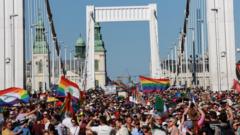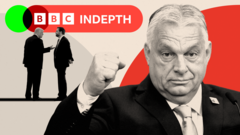This year's Budapest Pride saw a massive turnout, transforming into a vibrant display of solidarity and resistance to Prime Minister Viktor Orban's controversial laws.
**Budapest Pride: A Defiant Celebration Against Orban's Ban**

**Budapest Pride: A Defiant Celebration Against Orban's Ban**
Thousands gather in Budapest for Pride, turning the event into a celebration of rights and defiance against government restrictions.
The summer heat brought thousands to the streets of Budapest, transforming the celebrated Elisabeth Bridge and the banks of the Danube into a festive scene. Early estimates suggest that between 100,000 and 200,000 people, primarily young adults, participated in the Pride march, a stark rise from last year's turnout of merely 35,000.
The significant increase in participation was largely fueled by Orban's recent attempts to impose restrictions on the event, prompting many to join in as a statement of opposition. Banners and signs addressing the prime minister's governance were omnipresent, with slogans like, "In my history class, I learnt enough to recognise a dictatorship. You don't need to illustrate it - Vik!" being a common sight among the crowd.
The parade, which stretched across the city for hours, featured a mix of vibrancy from the LGBTQ+ community and broader human rights advocates, with Budapest’s Mayor Gergely Karacsony proudly declaring that the event exemplified their resilience against oppression. "We don’t exactly look as though we were banned!" he exclaimed, reveling in the moment of defiance against a government that has long marginalized diverse communities.
International voices also joined the cause, including Finnish MEP Li Andersson, who underscored the march's significance as a stand for universal rights rather than exclusively Pride. The controversial law cited by the government to justify the ban links LGBTQ+ representation with inappropriate content for children, sparking widespread backlash.
Despite the presence of law enforcement, their role was limited as the Pride event unfolded largely peacefully, showcasing a strong community spirit. In other areas, Orban participated in a ceremony for new law enforcement officers, simultaneously leveraging the pride narrative for his own agenda.
Media outlets aligned with the government criticized the event, labeling it as a chaotic display detached from the intent of freedom of assembly, while political analysts suggested a potential court fight could shape the future of such gatherings under the current regime.
As Pride in Budapest concluded, it left behind a powerful message: community resilience in the face of governmental oppression, highlighting the ongoing struggle for rights and recognition in Hungary.
The significant increase in participation was largely fueled by Orban's recent attempts to impose restrictions on the event, prompting many to join in as a statement of opposition. Banners and signs addressing the prime minister's governance were omnipresent, with slogans like, "In my history class, I learnt enough to recognise a dictatorship. You don't need to illustrate it - Vik!" being a common sight among the crowd.
The parade, which stretched across the city for hours, featured a mix of vibrancy from the LGBTQ+ community and broader human rights advocates, with Budapest’s Mayor Gergely Karacsony proudly declaring that the event exemplified their resilience against oppression. "We don’t exactly look as though we were banned!" he exclaimed, reveling in the moment of defiance against a government that has long marginalized diverse communities.
International voices also joined the cause, including Finnish MEP Li Andersson, who underscored the march's significance as a stand for universal rights rather than exclusively Pride. The controversial law cited by the government to justify the ban links LGBTQ+ representation with inappropriate content for children, sparking widespread backlash.
Despite the presence of law enforcement, their role was limited as the Pride event unfolded largely peacefully, showcasing a strong community spirit. In other areas, Orban participated in a ceremony for new law enforcement officers, simultaneously leveraging the pride narrative for his own agenda.
Media outlets aligned with the government criticized the event, labeling it as a chaotic display detached from the intent of freedom of assembly, while political analysts suggested a potential court fight could shape the future of such gatherings under the current regime.
As Pride in Budapest concluded, it left behind a powerful message: community resilience in the face of governmental oppression, highlighting the ongoing struggle for rights and recognition in Hungary.


















